Antipyretics for children are prescribed by a pediatrician. But there are emergency situations for fever when the child needs to be given medicine immediately. Then the parents take responsibility and use antipyretic drugs. What is allowed to give to infants? How can you bring down the temperature in older children? What medicines are the safest?
Most often, the legs occur in both adults and children. In most cases, with mild single spasms, massage and stretching of the muscle helps. But if the pathology appears frequently, it is better to consult a doctor. After all, regular cramps are necessarily evidence of problems in the body. And although they generally do not last longer than a minute and do not cause much discomfort, such a condition requires special treatment. Leg cramp pills are often prescribed, which act on the causes of the pathology and prevent spasms.
In infancy, capsules containing microspheres can be opened and administered in a soft, non-calcic food such as applesauce. Usually half the standard dose is given with snacks. There is great interindividual variability in response to enzymes, so a dosage range based on stool pattern and weight gain is recommended. After the start of enzyme therapy, there should be an almost immediate decrease in the frequency of stools and the degree of steatorrhea, improvement in symptoms abdominal cavity and decreased appetite. Most patients can achieve a fat absorption rate of over 85%.
The mechanism of seizures
Muscle contractions are controlled by nerve impulses. The work of skeletal muscles is subject to the brain and is an arbitrary process. But sometimes they can contract involuntarily, which is called a cramp. In this case, the muscle tenses for a while, usually from a few seconds to several minutes. It becomes solid sharp pain. At the same time, movement in this area of \u200b\u200bthe body is limited.
Some patients on high-dose enzyme therapy have persistent abdominal symptoms unrelated to exocrine pancreatic insufficiency. 83 In such cases, a 72-hour fecal fat measure and score for concurrent gastrointestinal disturbances are reported. The development of constipation in a patient taking enzymes may be an indicator for an increase in the amount of enzymes. A disintegrated reduction in enzyme dosage in this situation may precipitate an episode of distal ileus syndrome.
The most significant complication of pancreatic enzymes is fibrosing colonopathy, a condition associated with the use of high daily doses of the enzyme. Colon contraction, focal or extensive narrowing, and lack of distensibility are very suggestive. The diagnosis is confirmed by biopsy. Broadening of the intestinal wall, which may be a precursor to stricture formation, can be detected by ultrasonography. Most cases of fibrous colonopathy require hemicellulation. 86.
Most often, cramps occur in the calves of the legs, in the feet, the femoral muscle, or the hands. There may be spasms of the facial muscles, less often - the muscles of the body. Such single muscle contractions are called tonic convulsions. They are not dangerous and can occur to anyone. In contrast, clonic convulsions, or generalized spasms of most of the muscles of the body, are a serious pathology. They occur only in severe diseases, such as epilepsy or tetanus.
Replacement therapy of the pancreas
It is advisable to quantify the degree of malabsorption and the ability of therapy to correct it. A surprising number of pancreatic enzyme preparations are commercially available as tablets, capsules, enteric-coated microspheres, granules, and powders. Some products are not specifically for the treatment of exocrine pancreatic insufficiency, but for patients with unspecified abdominal pain. Some contain bile salts; in general, they should be avoided in patients with pancreatic insufficiency, as high concentrations of bile salts may exacerbate diarrhea.
Tonic convulsions occur due to disturbances in the transmission nerve impulses. This may occur due to pathologies nervous system, hormonal disruptions. But most often the cause of seizures is a violation of the electrolyte composition of the blood. After all, it is the minerals contained in it that ensure the normal functioning of the muscles. In order for them to contract and relax normally, they must be provided with magnesium, potassium, and calcium. In addition, a sufficient blood supply is needed to remove metabolic products. That is why leg cramps most often occur at night, when blood circulation slows down.
Drugs that are protected from peptic acid inactivation are preferred over unprotected drugs: unprotected ingested enzymes are largely degraded by increased stomach acid and lower pH. duodenum, secondary to depression of pancreatic bicarbonate secretion. The lipase content is the most an important factor determining the effectiveness of these products. Between 80% and 90% of unprotected ingested lipase and trypsin are inactivated in the stomach.
What causes spasms
Doctors consider the lack of minerals in the blood to be the main cause of tonic convulsions. This leads to disturbances in the transmission of nerve impulses to the muscles. That is why so often there are cramps in the legs in pregnant women. After all, the microelements in their body are almost all spent on the needs of the child. A lack of essential minerals can also occur with dehydration or certain medications.
The distribution of fat content in different meals and mixing enzymes with food in the duodenum seems to be important. Granules or microspheres are better than tablets because they allow more high activity enzymes reach the duodenum and mix with food. Thus, for the average adult, if there is some protection against gastric inactivation and an adequate enzyme-meal mixture exists, 2 to 10 capsules per meal can be expected to control steatorrhea.
Another common cause cramps in the calves of the legs is a violation of blood circulation. Varicose veins, thrombophlebitis, atherosclerosis and other pathologies cause congestion and lack of nutrients in the muscles.
In addition, leg cramps can occur for the following reasons:
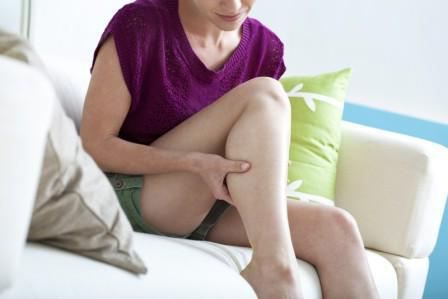
How to treat leg cramps
When a spasm has already arisen, it makes no sense to drink any pills. The cramp rarely lasts longer than 2 minutes, so it will stop on its own before the medication starts to work. In this case, urgent measures are needed. For example, rubbing a muscle, stretching it, a hot compress. Tablets for leg cramps are needed when they are repeated more than once a week or cause severe pain.
Studies done in children comparing conventional enzyme tablet therapy with intestinal-coated pancreatase microspheres have shown that significantly less steatorrhea and azotorrhea occurs with the use of the microsphere preparation. In addition, there is an improvement in compliance because significantly fewer capsules are required. Regardless of the drug used, there is strong evidence that enzymes must be properly delivered and evenly distributed during meals in order to achieve maximum food exposure to ingested enzymes.
Only well-chosen treatment can save the patient from pathology. Usually, drugs are used in combination with other means: massage, gymnastics, ointments. The duration of treatment is determined individually, but usually it is not more than 2-3 months. Only in the epileptic syndrome is lifelong therapy necessary.
Drugs used for seizures
With such a problem, rarely anyone goes to the doctor. People try to get rid of it on their own. And when they come to the pharmacy, they ask for anticonvulsant pills. But drugs with such an effect are used for epilepsy. They won't work for leg cramps. Tablets in this case are not used special, but those that eliminate the cause of the violation of muscle contractions. Therefore, it is better to still be examined by a doctor and find out why convulsions appear. After all, inappropriate drugs can only aggravate the situation.
The success of enzyme therapy is assessed by bowel symptoms, quantitative absorption tests such as fecal fat analysis, and maintenance normal nutrition. In children, growth assessment is also important. Azothorrhoea is more likely to be abolished by pancreatic enzymes than steatorrhea, possibly because trypsin secretion is better preserved than lipase secretion in pancreatic insufficiency, and because trypsin is not inactivated by acid, but only by pepsin. Poor response to pancreatic enzyme preparations may result from poor compliance, inappropriate timing of administration, the presence of another condition causing steatorrhea, or the use of an unprotected acid-sensitive enzyme preparation.
modern medicine is still researching how to treat leg cramps. There is no medicine that will get rid of them. Therefore, doctors often prescribe complex therapy. The following groups of drugs are used:

Are painkillers needed?
Seizures can cause severe pain. But they last no more than two minutes, so during the spasm itself it makes no sense to drink painkillers. But such drugs can be prescribed in complex therapy with frequent spasms. Usually used "Analgin" or "Paracetamol". They have a moderate analgesic effect.
Pancreas replacement. Monitor bone marrow annually for myelodysplasia and cytogenetic changes. Allogeneic hematopoietic stem cell transplantation: Indications and optimal timing of transplantation are unclear. Chemical class: pancreatic enzymes.
Mechanism of action: Digestive enzymes that replace endogenous pancreatic enzymes. Therapeutic effect: help in the digestion of protein, starch and fat. Pharmacokinetics: Not absorbed systemically. Goes to the duodenal transition.
A commonly used drug is Aspirin. Acetylsalicylic acid has the ability to thin the blood and improve blood circulation, so that the drug has not only an analgesic effect. Therefore, in the complex treatment of seizures, it is often prescribed.
Why are vitamins needed?
The composition of multivitamins includes all the trace elements necessary for the normal functioning of muscle tissue. Most often, seizures occur with a lack of magnesium, potassium and calcium. Therefore, the most common means are preparations containing only these trace elements.
▪ Unmarked Use: Treatment of occluded supply pipes. ▪ Contraindications: Acute pancreatitis, exacerbation chronic pancreatitis, hypersensitivity to pork protein. Allergic reaction, mouth irritation, shortness of breath, wheezing.
Excessive dose may cause nausea, convulsions and diarrhea. Hyperuricosuria and hyperuricemia have occurred with extremely high doses. Dosing substitution should be avoided. Enteric pancreatic enzymes are more effective than conventional formulations; individual variation may require testing with multiple enzyme preparations.

Venotonic drugs
In patients with varicose veins, leg cramps at night are common. This is due to lack of blood circulation in the muscles and congestion. To eliminate such violations, various venoprotective agents are prescribed.
High-lipase preparations appear to be more effective in reducing steatorrhea. Advise patient before or during meals. Protect the enteric coating; advise patient not to crush or chew microspheres in caps or tablets.
Do not spill Viocase powder on your hands as this may irritate your skin. Avoid inhaling the powder because it can irritate mucous membranes and produce bronchospasm. Do not change drug brands without first consulting your doctor.
Treatment of exocrine pancreatic insufficiency
▪ Geriatric side effects at first sight. The current clinical adage is that pancreatic enzyme replacement should start with malabsorption, and the principle is simple, replace inadequate pancreatic enzyme secretion by giving enzymes in the mouth. Unfortunately, although carbohydrate and protein malabsorption is mostly reversed by pancreatic enzymes, fat malabsorption rarely occurs due to insufficient pancreatic enzymes and because improper timing and schedule of enzyme and lipase intake can be inactivated by intragastric and intraduodenal acidity.
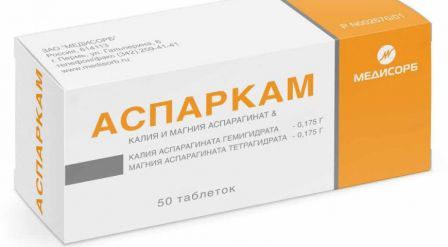
"Asparkam": application
In many cases, especially for leg cramps in the elderly, doctors recommend that patients take potassium and magnesium supplements. The most common of them is Asparkam. This preparation contains in the correct dosage magnesium and potassium, the lack of which is often the cause of convulsions. A doctor should prescribe this remedy, since it is necessary to take into account the level of these microelements in the blood. Useful "Asparkam" for heart disease, circulatory disorders, shock and convulsions.
Up to 90% of ingested enzymes are destroyed by acid in the stomach and acid and proteolytic breakdown by chymotrypsin and trypsin in the small intestine. To reverse malabsorption, ~10% of the normal enzyme output must be delivered to the duodenum. Although this dose rarely reverses steatorrhea, it usually reduces steatorrhea by 50%. Inadequate dosing can occur because the amount of enzymes in preparations varies between batches.
Choice of Pancreatic Enzymes: Non-Enteric or Enteric-Coated?
Pancreatic enzymes should be given with food. While taking enzymes every hour for 18 hours is as effective as taking enzymes with meals, a prandial schedule is more practical. Enteric-coated formulations must pass through the stomach and duodenum without lipase inactivation. However, when adequate doses of lipase are used, enteric enteric enzymes reduce steatorrhea to the same extent. The best delivery of lipase to the small intestine occurs with enteric-coated microspheres, but recovered steatorrhea due to smaller granules has not been confirmed.
It is necessary to take the drug for at least a month. Most often it is recommended to drink a tablet three times a day. Usually Asparkam is well tolerated, but sometimes nausea and abdominal pain may occur. This drug is contraindicated in violations of the kidneys. But "Asparkam" is often prescribed even to children and the elderly. Sometimes the drug is used by athletes during prolonged physical exertion. ![]()
Adjunctival acid suppression therapy
Lipase acid inactivation can be prevented by neutralizing or suppressing gastric acid secretion. However, magnesium-containing antacids and calcium carbonate are not helpful. Aluminum hydroxide is slightly beneficial. Low doses sodium bicarbonate are ineffective, and large doses are minimally effective. Conversely, histamine-2 receptor antagonist or proton pump inhibitor adjunctive drugs are very effective in reducing steatorrhea because they inhibit gastric acid secretion and also increase lipase and bile acid by reducing the volumetric flow of the duodenum.
"Magnerot": instruction
To compensate for the lack of magnesium, you need to drink special preparations for at least 1-2 months. But a person feels relief after a few days - the convulsions stop. One of the best means for this is "Magnerot". The instruction notes that it should be taken in violation of the heart rhythm and muscle spasms. It contains magnesium orotate dihydrate and auxiliary components.
Although adjuvant acid suppression therapy is useful, routine use cannot be justified due to cost, drug interactions, and long-term safety. It should only be used when rejection of steatorrhea is not achieved with conventional enzymes.
Thickening of the intestinal wall can be seen with ultrasonography and the formation of narrowing wounds. 34 Barium enema may show focal or generalized narrowing, with the most frequently affected colon being affected, although a common involvement of the large intestine has been reported. 35 Many patients show clinical improvement with reduction of supplemental enzymes and parenteral nutrition, but some require surgical resection of the narrowed colon. Given the reminder to reduce the incidence of fibrosing colonopathy.
The drug is well tolerated, but it is not recommended for children and patients with impaired renal function. In addition, it is sometimes possible allergic reactions. Assign "Magnerot" during the first week of treatment, 2 tablets three times a day, then it is enough to drink 1 piece. The course of treatment is set individually, but not less than a month. Sometimes a different regimen is recommended. If the patient is concerned about night cramps, you can drink 2-3 tablets before bedtime.
Multidisciplinary care is highly recommended. The main focus of treatment is pancreatic pancreatic replacement and fat-soluble vitamins for exocrine pancreatic insufficiency, but it is important to note that steatorrhea can spontaneously recur in up to 50% of elderly patients. Patients with learning difficulties may require special educational and psychological support. Treatment with granulocyte-colony-stimulating factor may be appropriate in patients with severe recurrent infections associated with neutropenia.
The use of "Troxerutin"
This drug is used for cramps caused by impaired circulation in the legs. Tablets "Troxerutin" are prescribed by a doctor, as they are contraindicated in diseases gastrointestinal tract. Sometimes this drug can cause allergic reactions.
But "Troxerutin" and its analogue "Troxevasin" are effective for venous insufficiency, trophic disorders in the limbs, and varicose veins. They improve blood circulation, relieve swelling, heaviness in the legs and cramps. 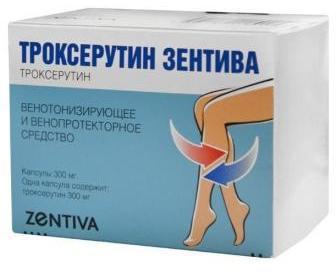
Tablets "Diosmin"
In many cases, cramps occur due to the fact that the venous outflow in the legs is disturbed, and the muscles do not receive the necessary nutrients. Taking the drug for 2 months allows you to forget about such spasms for a long time. Tablets "Diosmin" are considered the best of the venoprotectors, which, in addition, still has a natural composition.
The drug helps to tone and strengthen the walls of blood vessels, improve blood circulation, relieve inflammation. You need to take it 3 tablets twice a day. Sometimes "Diosmin" can cause allergic reactions, headaches, nausea
The drug "Quinidine"
These pills for leg cramps are prescribed only as a last resort. The drug contains quinine, which has long been used in medicine, but for the treatment of malaria. This remedy also has the ability to remove the tendency to convulsions. But Quinidine has many dangerous side effects. These pills are especially toxic for a developing child. Therefore, they are never used for leg cramps in pregnant women.
"Quinidine" can be used only as prescribed by a doctor in a strictly individual dosage. If it is exceeded, the patient may begin problems with vision and hearing, heart rhythm disturbance, nausea, headaches.
Anticonvulsants
With an intense convulsive syndrome, special means are needed. These are barbiturates, valproic acid preparations, various benzodiazepine-based sedatives. They are required for epilepsy, nervous disorders, as well as generalized convulsions caused by certain infectious diseases. With ordinary spasms of the muscles of the legs, such remedies are not recommended.
Quite unpleasant sensations, manifested as a result of muscle spasms, more often calf, are familiar to almost everyone.
For some, leg cramps (myoclonus or clonic spasms) are rare, while for others, painful muscle spasms are regular. The manifestation of myoclonus is a consequence functional disorders and is not an independent disease.
By themselves, unexpected muscle contractions are not a concern. Anxiety is caused by unreasonable, fairly long-lasting, regular repetitions. Spasms in the muscles of the legs can manifest as an idiopathic (self-occurring) symptom, or be a manifestation of a symptom of an underlying underlying disease.
Why are my legs cramping?
The mechanism and causes of the development of clonic leg cramps and calf muscles is identical for all ages and manifests itself as a result of violations of three components:- in violation of the water-salt balance in muscle cells;
- with inadequately low blood supply in soft tissues;
- with neurological disorders.
Electrolyte pathologies- the most common condition leading to calf spasms and leg cramps. In a normal state, the reaction of muscle tissue is possible in a certain phase of tension within and extracellular ionic concentration, which creates movement in various directions of current flow of necessary microelements.
Various pathological processes, leading to an imbalance of the necessary elements, provoke violations of muscle contractions. The main problem is the lack of elements of the main subgroup - calcium and sodium compounds, leading to clonic muscle spasms.
The most characteristic manifestations of leg cramps are expressed:
- 1) Dehydration of the 2nd and 3rd degree, as a result of which prerequisites for blood clotting are created, a decrease in the level of sodium compounds in the plasma, which contributes to the development of myoclonus. The same situation manifests itself in severe bleeding, with a sharply reduced total volume of blood in functioning vessels.
- 2) In case of inadequate diuretic therapy, Henle's loop diuretics and inhibitors that remove valuable trace elements from the body - sodium and magnesium compounds. The reduced concentration of which causes an increase in the stimulation of nerve impulses and creates the preconditions for convulsive reactions. This appearance of convulsive spasms is a common occurrence in losing weight women of fashion with uncontrolled intake of diuretics and in elderly patients. Myoclonus manifests itself at night with a slight change in the position of the legs with calf spasms or muscle twitches.
- 3) Inadequate fluid and electrolyte therapy - intravenous transfusions create sharp jumps in capillary pressure volume, which creates electrolyte disturbance leading to seizures.
- 4) The state of pregnancy - the lack of trace elements of calcium is due to the cost of intrauterine development of the child and entails clonic spasms of the ankle.
- 5) Progression of liver disease () - a change in the level of protein in the blood plasma (hypoalbuminemia) causes dropsy edema in the tissues of the pericardial sac, in the tissues of the pleura and peritoneum, which also contributes to the formation of caviar cramps.
- 6) As a result of hemodialysis - oxygen starvation of the kidneys contributes to the deposition of toxins and toxins, resulting in excessive formation and accumulation of lactic acid. and serotonin, a neurotransmitter
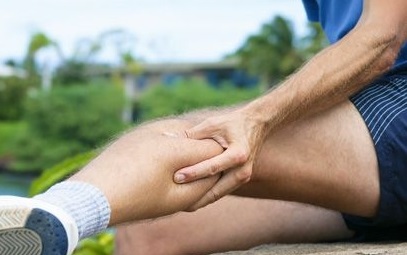
Insufficient circulation of soft tissues
In addition, leg cramps are due to the following pathologies, due to which there is a violation of blood circulation, and as a result, the occurrence of seizures.- 1) Complete or partial disruption of blood supply to the tissues causes spastic pain and convulsive muscle contractions. Such a pathology, with insufficient blood supply, is manifested by the development of myoclonus in the ankle muscles as a result of metabolic disorders and limited distribution of dextrose in tissue cells.
- 2) With the manifestations of myoclonus, they can manifest themselves in the form of convulsive reactions in the caviar muscles, especially after long walks. Their manifestation is characteristic in people who, due to their professional activities, are forced to spend a long time standing. Including in pregnant women, who contribute to varicose veins intra-abdominal pressure.
- 3) Low blood sugar caused by fasting or hypoglycemic conditions cause calf cramps due to blood flow disorders in the limbs caused by impaired tissue metabolism.
- 4) Pathological changes feet in the form - the cause of spasm of muscle tissue lies in the incorrect distribution of the load on the legs, the deterioration of blood supply and compression of the neurovascular bundles. It usually manifests itself when wearing tight shoes or shoes with high heels.
- 5) Raynaud's disease - characteristic disorders in the capillary blood flow cause pathologies of protective reflexes and a decrease in muscle tone, the result is myoclonus. With such a pathology, the limbs react sharply to the manifestation of cold air and water with clonic spasms.
Causes of seizures as a result of neurological disorders
Leg cramps can also occur due to neurological disorders.- 1) Presynaptic disorders caused by various kinds of intoxications, infections, bites of some insects. An overdose of the vitamin D preparation causes a sharp spasmodic muscle contraction in children.
- 2) Acute disorders of the cerebral vessels also cause the manifestation of muscle cramps in the legs. Accompanied by continuous, throbbing headaches, goosebumps, flickering in the eyes, clouding of consciousness.
- 3) Children's hyperthermia in many cases does not exclude convulsive manifestations in the leg calves.
- 4) Frequent manifestations of clonic convulsions in pathologies in articular cartilage- the result of compression of nerve motor fibers.
Causes of leg cramps at night
During a night's sleep, muscle activity is significantly reduced, but sleeping in a hot room contributes to the accumulation of lactic acid in caviar tissues, which contributes to the manifestation of painful clonic convulsions.Involuntary muscle contraction can also provoke heavy loads on the legs the day before, especially people who experience vascular problems, when there is chronic venous insufficiency, and arterial blood flow disturbance causes tissue hypoxia and contributes to spastic manifestations.
Causes of leg cramps in a healthy person
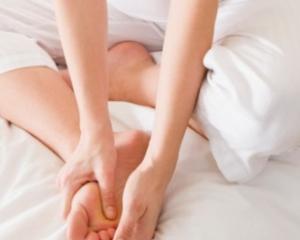 Clonic cramps in the legs can be absolutely prone to healthy man.
Clonic cramps in the legs can be absolutely prone to healthy man. Seizures occur for a variety of reasons:
- with prolonged, strong muscle tension;
- as a result of prolonged forced position of the body;
- due to household and professional loads;
- when exercising in the cold.
What to do when legs cramp?
The first thing to do when your legs cramp is to drop the panic and focus.Inhaling as much air as possible, dive, bend your knees and pull them to your chest. Strongly clasp your hands (in turn), pull your toes, and pull them as close as possible to the lower leg, thereby unlocking the “clamped” calf muscles.
In this case, the foot serves as a lever that stretches muscle tissue, and return it to its normal state.
Treating leg cramps
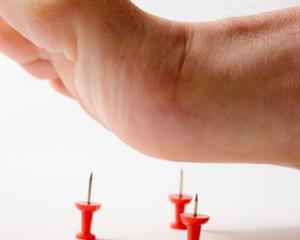 With frequent repetitions of cramps in the legs, as well as for their effective treatment necessary medical examination for differentiation:
With frequent repetitions of cramps in the legs, as well as for their effective treatment necessary medical examination for differentiation: - electrolyte imbalance;
- exclusion of endocrine pathologies;
- the presence of vascular disorders.
Loss of fluid during vomiting and diarrhea is replenished by taking Regidron, Hydrovit or similar drugs. Exclude uncontrolled use medicines and diuretic drugs.
For women of an "interesting position", for preventive purposes, replenish the calcium reserve with drugs selected by the doctor. As a momentary help for convulsive spasms in the legs, quite simple methods are used:
- stretching the muscles of the ankle by walking on tiptoe;
- unbend the foot with your hands in a prone position;
- pulling up on yourself thumbs legs;
- hot compresses on the calves;
- muscle relaxation with a light massage;
- the most effective method is shaking the leg with careful kneading and stroking.
Which doctor should I contact for treatment?
If, after reading the article, you assume that you have symptoms characteristic of this disease, then you should



